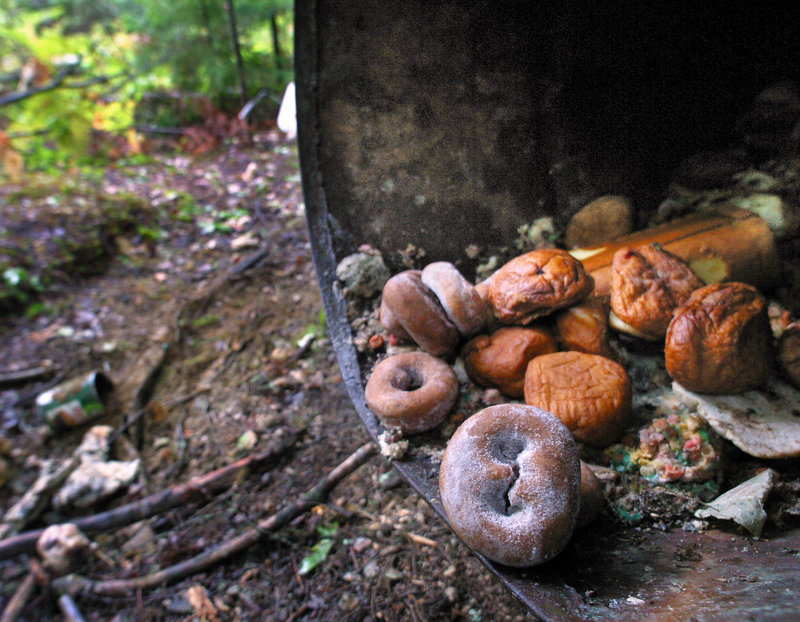Bear hunting starts Monday and runs through Nov. 26, a three-tier season with specific dates set aside for baiting, hunting with dogs and — for want of a better term — using fair-chase methods.
Hunters can sit over man-placed bait from Monday through Sept. 24, a hunting technique that accounts for about 80 percent of the annual kill in the short four-week season. Folks hunting over bait often hire a guide for the labor-intensive sport, but exceptions exist. More on that later.
The 80 percent figure varies a little each year, depending on the availability of natural foods. The harvest number drops a little when wild crops grow abundantly, pulling some bears away from bait piles.
Hunters with bear hounds have from Sept. 12 through Oct. 28 — often a guided hunt too — and they take part of the final 20 percent of the bears.
Deer hunters in the regular firearms season for deer from Oct. 29 to Nov. 26 shoot a portion of the 20 percent — a “bonus” bear while targeting deer. That number rises in years with late snowfall, keeping bruins from going into hibernation until along toward Thanksgiving weekend.
Hunters can employ fair-chase tactics such as still-hunting, stalking or sitting over natural bait or game trails for the entire three-month season. Success requires great hunting skills, so with the exception of deer hunters in November, this group tags but a small percentage of the overall harvest.
The bear-season structure looks complicated, but the Department of Inland Fisheries and Wildlife uses constants for the dates.
In short, for years now, the hunt always starts the last Monday of August and ends the Saturday after Thanksgiving. Hunters can use bait for the first four weeks, and folks with hounds can start the third Monday after the opener and continue through the Friday before the regular firearms season for deer kicks off for residents — a seven-week hunt for dog handlers.
The bear season once began Sept. 1, but that left guides with less than a full week to book clients on opening week. When IFW officials chose Monday as the opening day, it ended the problem and offers a perfect example of bureaucrats and politicians in Augusta getting it right.
Do-it-yourself baiting offers baiters great fun but requires lots of time to put food out daily, crucial to keep these big, wary game animals coming. Years ago, I baited bear each fall and can tell you it is a rush to get an animal coming every day and using tricks to determine size.
My six favorite ingredients for baiting included lobster heads for “stink bait,” oil of anise, molasses, bacon fat and fresh meat scraps and bones.
I froze lobsters heads in separate garbage bags and did the same with the meat and bones, which might bring a howl of protest from folks in the know. Bear ingest plastic, which cannot be good.
However, I strung wire eight to nine feet off the ground between two widely spaced trees and hung the garbage bags of food so the bottoms were six feet up. Bears cuffed at the bags to dump the food out, and it took a large bear to pull a whole bag down. The empty bags would just hang on the wire.
The idea of having food bags too high for small bears to reach allegedly kept little ones away, but it wasn’t foolproof. Big bears left scraps on the ground for the smaller bears.
“Stink bait” is no exaggeration. Lobster heads hanging in plastic bags in the sun can really stink, which drew bruins from far and wide. The meat-and-bone scraps could choke a skunk, too, when they got ripe.
During my baiting days, and this is easily debatable, I noticed that the rotten smell drew bears, but they preferred eating fresh meat. Given a choice, they’d eat the newer bait and leave the smelly stuff. Exceptions occurred, but that’s exactly what they were — exceptions.
Guides must deal with rotten meat because of the sheer volume, but a recreational baiter like me could put fresh meat and lobster heads into plastic bags and freeze them in a chest-styled freezer bought just for that purpose.
I’ve also experimented, and given a choice, it seems bears like fresh meat, particularly in comparison to grain and dog food. Pastries rivaled meat most of the time, but my donut supply was limited.
Oil of anise proved a wicked draw — an expensive option if someone used lots of it — and I did.
One trick worked for sizing bears — molasses, oil of anise and/or bacon fat on a Styrofoam tray. Bears would bite the coated tray and give me an accurate method of determining the width between the teeth.
I used a bow and arrow over bait — never a firearm — though I have nothing against folks using a rifle, muzzleloader or handgun.
NOTE
This column started in March 1988, and this one makes number 1,300. I want to thank all the people who have given me encouragement, advice, corrections and rants through the years. I truly appreciate the responses.
Ken Allen of Belgrade Lakes is a writer, editor and photographer. He can be contacted at:
KAllyn800@yahoo.com
Send questions/comments to the editors.



Success. Please wait for the page to reload. If the page does not reload within 5 seconds, please refresh the page.
Enter your email and password to access comments.
Hi, to comment on stories you must . This profile is in addition to your subscription and website login.
Already have a commenting profile? .
Invalid username/password.
Please check your email to confirm and complete your registration.
Only subscribers are eligible to post comments. Please subscribe or login first for digital access. Here’s why.
Use the form below to reset your password. When you've submitted your account email, we will send an email with a reset code.